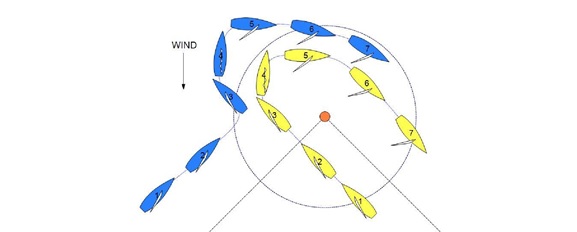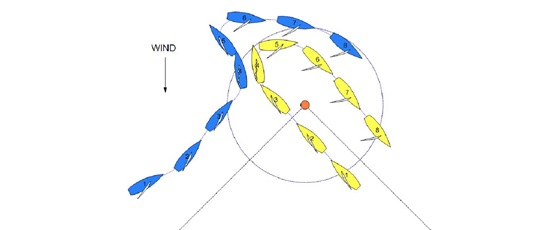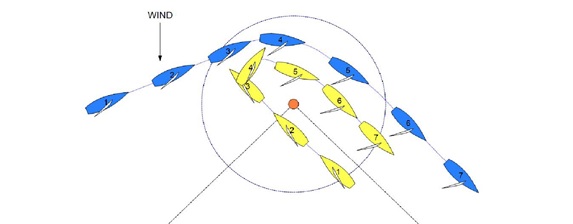


Section E - The Windward Mark
MR CALL E8
Rule 10, On Opposite Tacks
Rule C2.6 (13.1), While Tacking or Gybing
Rule C2.9 (18.2(a)(1)), Giving Mark-Room (overlapped)
Rule C2.9 (18.3(b)), Tacking or Gybing
Rule C6.5(b), Umpire Decisions
Rule C8.3, Penalties Initiated by Umpires
Definitions , Keep Clear, Mark-Room (rule C2.2), Proper Course
(rule C2.3)
Question 1
Blue on port tack and Yellow on starboard tack are approaching the windward mark
on a collision course. The umpires agree that Yellow sails beyond the point where
her proper course would be to tack to round the mark. Blue tacks to starboard and
keeps clear of Yellow. Flag Y is displayed at position 4. What should the call be?

Answer 1
Penalize Yellow with a red flag (or possibly a double).
When Yellow first enters the zone overlapped inside Blue, she is entitled to markroom
under rule C2.9 (18.2(a)(1)). However, as an inside overlapped right-of-way
boat, Yellow breaks rule C2.9 (18.3(b)) by sailing farther from the mark than needed
to sail her proper course before she changes tack, and in doing so she affects Blue’s
course. Display the yellow flag.
A boat is in a ‘controlling position’ when she is ahead and able to manoeuvre towards
the next mark without impediment, or she is in a position to be able to impede, affect
or change the actions of the other boat without breaking a rule.
Because Yellow could not force Blue to tack without breaking rule 18.3(b), she was
not in a ‘controlling position’ in this situation. By breaking rule 18.3(b) and forcing
Blue to tack Yellow gained a controlling position.
If the umpires were satisfied that Yellow has broken rule 18.3(b) deliberately or has
gained an advantage by breaking the rule after allowing for a penalty, they would
give Yellow a second penalty under rule C8.3. See also MR Call M2.
If the umpires were not satisfied that either of these conditions existed, the umpires
would give Yellow a red-flag penalty under rule C6.5(b).
Question 2
Blue on port tack and Yellow on starboard tack are approaching the windward mark
on a collision course. The umpires agree that Yellow sails beyond the point where
her proper course would be to tack to round the mark. Blue tacks to starboard to
avoid Yellow, but before she reaches a close-hauled course Yellow has to luff to
avoid Blue. Both boats display flag Y at position 4. What should the call be?

Answer 2
Penalize Yellow with a red flag (or possibly a double) and Blue.
Blue breaks rule C2.6 (13.1) by not keeping clear while tacking. Because Blue is
neither compelled to break a rule, nor entitled to room or mark-room, she is not
exonerated for her breach.
Yellow, the inside overlapped right-of-way boat, breaks rule 18.3(b) by sailing
farther from the mark than needed to sail her proper course before she changes tack,
and affects Blue’s course while doing so.
Coming into the situation, neither boat was in a controlling position because neither
boat could impede, affect or change the other boat’s course while complying with
the applicable rules. See Answer 1. By breaking rule 18.3(b), Yellow gained a
controlling position on Blue.
If the umpires were satisfied that Yellow broke rule 18.3(b) deliberately or gained
an advantage by breaking the rule after allowing for a penalty, they would give
Yellow a second penalty under rule C8.3. This should be a red-flag penalty under
rule C5.3 (red and second yellow flag) so that Yellow is behind Blue in the race. See
also MR Call M2.
If the umpires were not satisfied that either of these conditions existed, the umpires
would give Yellow a red-flag penalty under rule C6.5(b) (yellow and then red flag).
This would put Yellow behind Blue and Blue would still have a penalty.
Question 3
Blue on port tack and Yellow on starboard tack are approaching the windward
mark on a collision course. The umpires agree that Yellow sails beyond the point
where her proper course would be to tack to round the mark. Blue holds her course.
Yellow has to tack to avoid Blue. Both boats display flag Y at position 4. What
should the call be?

Answer 3
Penalize Blue with a red flag (or possibly a double) and Yellow (with possibly a
double).
Yellow, the inside overlapped right-of-way boat, breaks rule 18.3(b) by sailing
farther from the mark than needed to sail her proper course before she changes tack
and affects Blue’s course while doing so (Blue is unable to bear away to round the
mark).
Blue breaks rule 10 by not keeping clear. Because Blue is neither compelled to break
a rule, nor entitled to room or mark-room, she is not exonerated for her breach.
Coming into the situation, neither boat was in a controlling position because neither
boat could impede, affect or change the other boat’s course while complying with
the applicable rules. See Answer 1.
If the umpires were satisfied that Yellow broke rule 18.3(b) deliberately, they would
give Yellow a second penalty under rule C8.3. See also MR Call M2.
By breaking rule 10, Blue has gained a controlling position. If the umpires were
satisfied that Blue has broken rule 10 deliberately or has gained an advantage by
breaking the rule after allowing for a penalty, they would give Blue a second penalty
under rule C8.3. See also MR Call M2.
If the umpires give both Yellow and Blue a double penalty, then Blue‘s second
penalty should be a red-flag penalty under rule C5.3 (red and second blue flag) as
Blue gained a controlling position. This would put Blue behind Yellow and Yellow
would still have a penalty.
If the umpires were not satisfied that either of these conditions existed, the umpires
would give Blue a red-flag penalty under rule C6.5(b).








